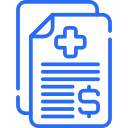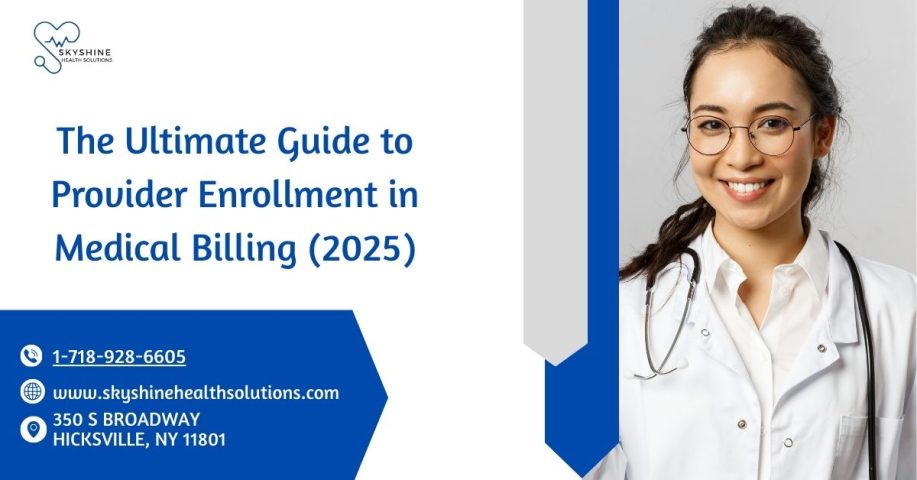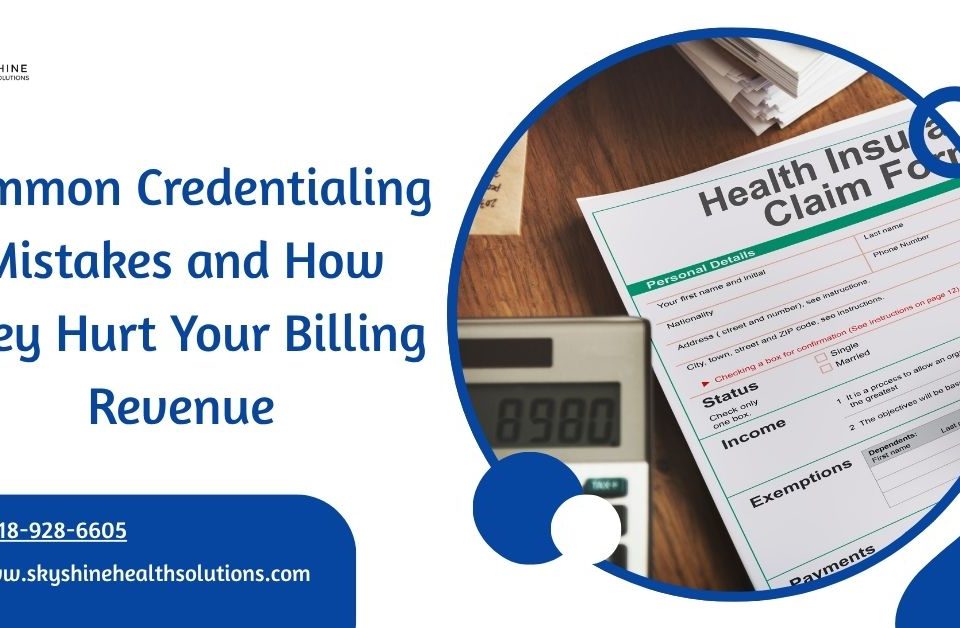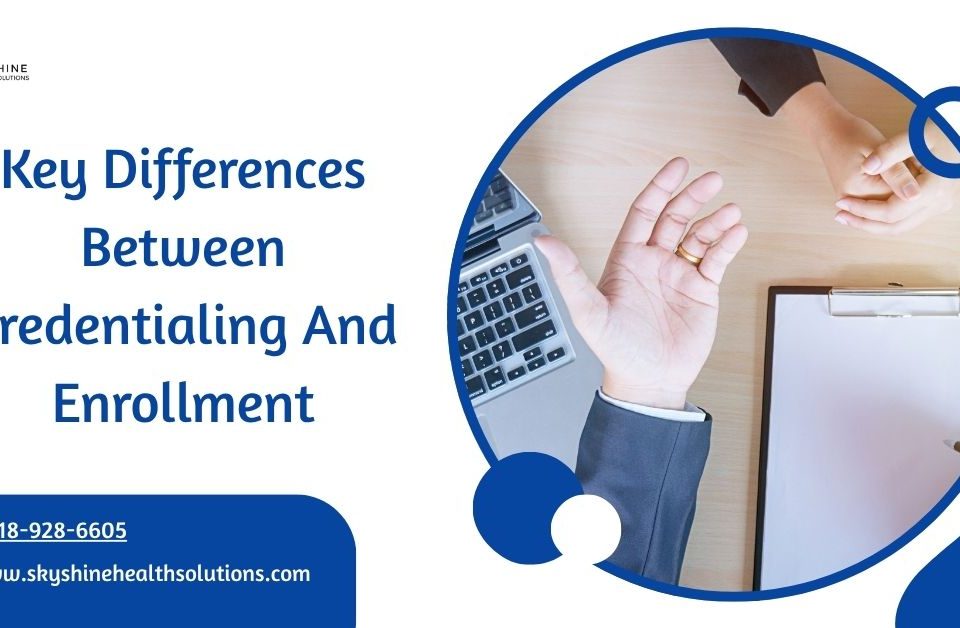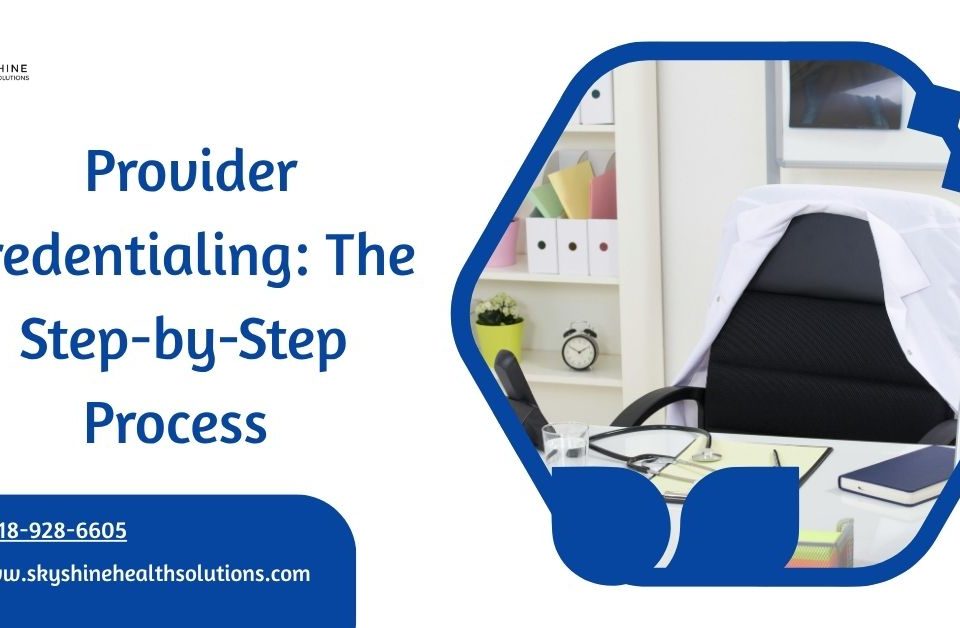
Common Medical Billing Mistakes Clinics Make
June 11, 2025
Why Credentialing Verification Matters in medical billing 2025
June 17, 2025Provider enrollment is a critical step in medical billing, ensuring healthcare providers are registered with insurance payers to receive reimbursements for services. A seamless enrollment process can save time, reduce claim denials, and keep your practice’s revenue cycle on track. In this guide, we’ll break down the provider enrollment process, share actionable tips to streamline it, and highlight best practices to avoid costly delays.
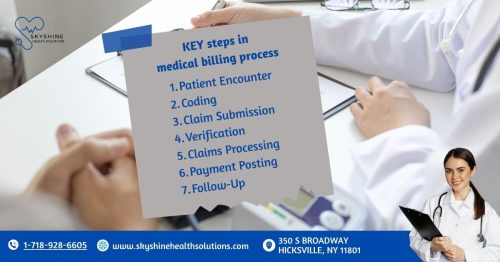
What Is Provider Enrolment in Medical Billing?
Provider enrollment is the process of registering healthcare providers with insurance payers, such as Medicare, Medicaid, or commercial insurers, to bill for services. It involves submitting detailed documentation about a provider’s qualifications, including licenses, certifications, and National Provider Identifier (NPI) numbers. Successful enrollment ensures providers are recognized by payers, enabling claims to be processed and paid efficiently.
Without proper enrollment, claims can be denied, leading to revenue loss and administrative headaches. Understanding the process and optimizing it is essential for medical practices of all sizes.
Why Is Provider Enrollment Important?
-
-
-
Ensures Reimbursement: Only enrolled providers can bill and receive payments from payers.
-
Reduces Claim Denials: Proper enrollment minimizes errors that lead to rejected claims.
-
Maintains Compliance: Meets federal, state, and payer-specific regulations, such as those from CMS.
-
Builds Trust: Credentialed providers signal professionalism and reliability to patients and payers.
-
-
Steps to Streamline Provider Enrollment
Streamlining provider enrollment requires organization, attention to detail, and proactive planning. Follow these steps to make the process efficient and error-free.
1. Gather Required Documentation Early
Payers require extensive documentation to verify a provider’s credentials. Preparing these in advance can significantly speed up the process. Common documents include:
-
-
-
NPI Number: Apply for or verify the provider’s NPI through the National Plan and Provider Enumeration System (NPPES).
-
Licenses and Certifications: Ensure all professional licenses and board certifications are up to date.
-
Education and Training Records: Provide proof of medical education, residency, and fellowships.
-
Malpractice Insurance: Submit proof of current coverage.
-
Work History: Include a detailed employment history, often required for the past five years.
-
Tax ID and Practice Information: Provide details about the practice, including EIN and billing address.
-
-
Pro Tip: Create a checklist for each payer, as requirements may vary. Use a secure digital folder to store and organize documents for easy access.
2. Leverage the CAQH ProView System
The Council for Affordable Quality Healthcare (CAQH) ProView is a centralized platform for managing provider data. Many commercial payers use CAQH to streamline credentialing and enrollment. Here’s how to use it effectively:
-
-
-
Complete Your CAQH Profile: Enter all required information, including licenses, certifications, and practice details.
-
Keep It Updated: Regularly review and update your profile to avoid delays during re-credentialing.
-
Grant Payer Access: Authorize payers to access your CAQH profile to reduce redundant paperwork.
-
-
Using CAQH can save hours of repetitive data entry and ensure consistency across multiple payer applications.
3. Understand Payer-Specific Requirements
Each payer has unique enrollment requirements and timelines. For example:
-
-
-
Medicare: Requires enrollment through PECOS (Provider Enrollment, Chain, and Ownership System).
-
Medicaid: Varies by state, with specific forms and deadlines.
-
Commercial Payers: May require additional forms, such as payer-specific applications or contracts.
-
-
Research each payer’s guidelines thoroughly. Contact their provider enrollment team for clarification if needed, and note any deadlines to avoid delays.
4. Submit Accurate and Complete Applications
Errors or incomplete applications are a leading cause of enrollment delays. To ensure accuracy:
-
-
-
Double-Check Information: Verify all data, including NPI numbers, addresses, and license numbers.
-
Use Digital Tools: Use software or templates to autofill repetitive fields and reduce manual errors.
-
Include All Supporting Documents: Ensure every required document is included in the submission.
-
-
Pro Tip: Assign a dedicated staff member to review applications before submission to catch any discrepancies.
5. Track Application Status
Payer enrollment can take weeks or even months, depending on the payer. Actively tracking your application status can help you address issues promptly:
-
-
-
Follow Up Regularly: Contact payers to confirm receipt and check for updates.
-
Use Tracking Tools: Many practices use credentialing software to monitor application progress.
-
Document Communication: Keep a log of all interactions with payers, including dates and contact names.
-
-
Proactive follow-up can prevent applications from getting lost or delayed in the system.
6. Plan for Re-credentialing
Enrollment isn’t a one-time task. Most payers require re-credentialing every 2-3 years to verify that providers remain in good standing. To stay ahead:
-
-
-
Set Reminders: Use a calendar or credentialing software to track re-credentialing deadlines.
-
Update Documents: Ensure licenses, certifications, and malpractice insurance are current.
-
Monitor CAQH: Keep your CAQH profile updated to simplify re-credentialing.
-
-
Common Pitfalls to Avoid
Even experienced practices can encounter issues during provider enrollment. Watch out for these common mistakes:
-
-
-
Incomplete Documentation: Missing or outdated documents can lead to immediate rejections.
-
Incorrect NPI Information: Ensure the NPI matches the provider’s name and practice details.
-
Missing Deadlines: Late submissions can delay enrollment by weeks or months.
-
Ignoring Payer-Specific Forms: Some payers require unique forms that aren’t part of CAQH.
-
-
How to Use Technology to Simplify Enrollment
Modern technology can make provider enrollment faster and more efficient. Consider these tools:
-
-
-
Credentialing Software: Platforms like Modio Health or CredSimple automate document management and application tracking.
-
Electronic Submission Portals: Many payers offer online portals for faster submission and processing.
-
Practice Management Systems: Integrate enrollment tracking with your existing billing software for a seamless workflow.
-
-
Investing in the right tools can save time and reduce errors, especially for practices managing multiple providers.
The Impact of Provider Enrollment on Your Revenue Cycle
Delays or errors in provider enrollment can have a ripple effect on your practice’s revenue cycle. Unenrolled providers cannot bill for services, leading to delayed payments or claim denials. By streamlining enrollment, you can:
-
-
-
Accelerate Cash Flow: Faster enrollment means quicker reimbursement.
-
Reduce Administrative Costs: Fewer errors mean less time spent on rework.
-
Improve Patient Care: Providers can focus on patients instead of administrative tasks.
-
-
Conclusion
Provider enrollment is a cornerstone of successful medical billing, but it doesn’t have to be a headache. By gathering documents early, leveraging tools like CAQH, and staying proactive with payers, you can streamline the process and keep your practice running smoothly. Avoiding common pitfalls and using technology can further enhance efficiency, ensuring your providers are enrolled quickly and your revenue cycle stays on track.
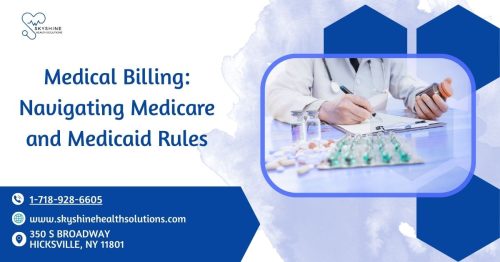
Learn more about medical billing on Medical Billing: Navigating Medicare and Medicaid Rules
Check how we are improving lives Reviews

